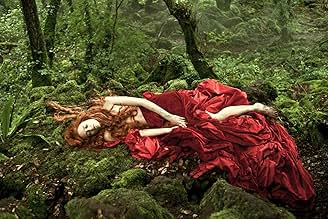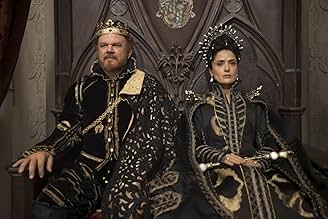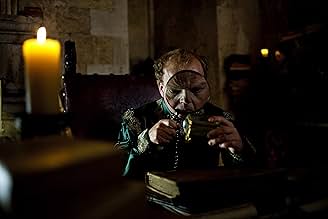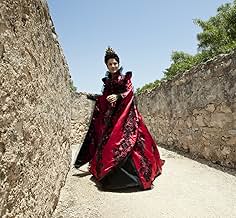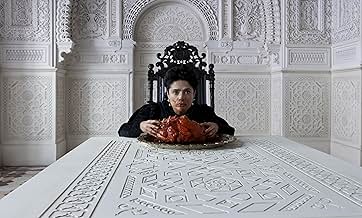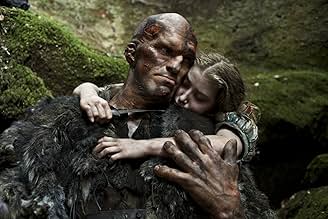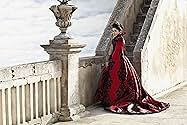Da amarga busca da Rainha de Longtrellis, a duas irmãs misteriosas que provocam a paixão de um rei, ao Rei de Highhills obcecado por uma pulga gigante, esses contos são inspirados nos contos... Ler tudoDa amarga busca da Rainha de Longtrellis, a duas irmãs misteriosas que provocam a paixão de um rei, ao Rei de Highhills obcecado por uma pulga gigante, esses contos são inspirados nos contos de fadas de Giambattista Basile.Da amarga busca da Rainha de Longtrellis, a duas irmãs misteriosas que provocam a paixão de um rei, ao Rei de Highhills obcecado por uma pulga gigante, esses contos são inspirados nos contos de fadas de Giambattista Basile.
- Prêmios
- 21 vitórias e 15 indicações no total
Enredo
Você sabia?
- CuriosidadesThe movie was based on the Pentamerone ("The Tale of Tales, or Entertainment for Little Ones"), a collection of fairy tales by 17th century Italian poet and courtier Giambattista Basile.
- Erros de gravaçãoIn the credits the name of the Italian composer Girolamo Frescobaldi (1584-1643) is misspelled 'Frescobladi'.
- Cenas durante ou pós-créditosDedication before end credits: "To Nico and Marco"
- ConexõesFeatured in Medieval Weapons Master Rates 11 Weapons and Armor n Movies and TV (2020)
- Trilhas sonorasSe l'aura spira tutta vezzosa, F 7.15
Composed by Girolamo Frescobaldi
Avaliação em destaque
The royal court roars with laughter. A group of jesters grin and jeer at one another, do cartwheels, breathe fire. In the midst of all this mirth, the Queen sits sad and silent on her throne. Her eyes fall on one of the players and suddenly she runs off, distraught. The King chases after her, shouting that he is sorry, that he did not know. His apologies fall on deaf ears.
So begins Tale of Tales, Matteo Garrone's visually striking, but ultimately uninspiring adaptation of the Pentamerone, a book of Italian folk stories collected in the 17th century.The film cuts between three separate narrative strands, linked together by the unifying theme of all-consuming obsession. One tale centres around a monarch mad with lust, and two crones in his kingdom who desire only to be young again. Another depicts a woman who will do anything for motherhood. The third tale introduces us to a king's unhealthy fascination with a flea, and an ogre unable to set free his reluctant and unhappy bride.
Fairy tales these may be, but their delightfully disturbing content ensures that they are not meant for children. (At least by modern, if not by 17th century standards – the Pentamerone, just as full of sex and violence as Garrone's 15 rated film, was subtitled 'Entertainment for Little Ones'). Yet even though Tale of Tales is too graphic and gruesome for kids and is clearly aimed at older audiences, it remains too childishly straightforward to be captivating. I would have needed either more nuance or more mystery and suggestion for the film to draw me in and immerse me in its world. There are, for instance, scenes where characters morph into a different physical shape. Had these transformations remained unexplained by the narrative they would have evoked a sense of wonder and significance, like visual poems hinting at some elusive but compelling underlying idea. Instead, the characters transform because a magician cast a spell, and there is nothing to think about. It is the kind of simple cause and effect storytelling with a clear moral – for all three narrative strands put forward the idea that 'obsession is not good for you' – which works so well for children's stories, but is too obvious to really interest adults.
To be fair, it was never Garrone's intention to prompt intellectual engagement with Tale of Tales. 'Don't try to understand it. Just feel it, like when you are standing in front of a painting. Follow the characters, take the journey, feel the emotion,' the director said in a Guardian interview. But the characters are too one-dimensional to seem real, and I found it hard to care about their lives or fates. They also speak far too much to function well as figures onto whom one can project emotion, like when one is standing in front of a painting. It should have been show not tell, with the camera lingering on the characters' facial expressions, and allowing spectators to empathise and identify with them. Instead, feelings, from love to longing, are spoken – 'He's like a brother to me', 'I want to be young again' – and the action moves forward.
Less would have been more, with Tale of Tales. The power of the film lies in its visuals, which are beguiling, gorgeous and grotesque. The dialogues and narrative explanations serve only to trivialise the images, lessening the overall effect of the film. The trailer for Tale of Tales, a succession of visuals set to nothing but music,is better than the film itself.
So begins Tale of Tales, Matteo Garrone's visually striking, but ultimately uninspiring adaptation of the Pentamerone, a book of Italian folk stories collected in the 17th century.The film cuts between three separate narrative strands, linked together by the unifying theme of all-consuming obsession. One tale centres around a monarch mad with lust, and two crones in his kingdom who desire only to be young again. Another depicts a woman who will do anything for motherhood. The third tale introduces us to a king's unhealthy fascination with a flea, and an ogre unable to set free his reluctant and unhappy bride.
Fairy tales these may be, but their delightfully disturbing content ensures that they are not meant for children. (At least by modern, if not by 17th century standards – the Pentamerone, just as full of sex and violence as Garrone's 15 rated film, was subtitled 'Entertainment for Little Ones'). Yet even though Tale of Tales is too graphic and gruesome for kids and is clearly aimed at older audiences, it remains too childishly straightforward to be captivating. I would have needed either more nuance or more mystery and suggestion for the film to draw me in and immerse me in its world. There are, for instance, scenes where characters morph into a different physical shape. Had these transformations remained unexplained by the narrative they would have evoked a sense of wonder and significance, like visual poems hinting at some elusive but compelling underlying idea. Instead, the characters transform because a magician cast a spell, and there is nothing to think about. It is the kind of simple cause and effect storytelling with a clear moral – for all three narrative strands put forward the idea that 'obsession is not good for you' – which works so well for children's stories, but is too obvious to really interest adults.
To be fair, it was never Garrone's intention to prompt intellectual engagement with Tale of Tales. 'Don't try to understand it. Just feel it, like when you are standing in front of a painting. Follow the characters, take the journey, feel the emotion,' the director said in a Guardian interview. But the characters are too one-dimensional to seem real, and I found it hard to care about their lives or fates. They also speak far too much to function well as figures onto whom one can project emotion, like when one is standing in front of a painting. It should have been show not tell, with the camera lingering on the characters' facial expressions, and allowing spectators to empathise and identify with them. Instead, feelings, from love to longing, are spoken – 'He's like a brother to me', 'I want to be young again' – and the action moves forward.
Less would have been more, with Tale of Tales. The power of the film lies in its visuals, which are beguiling, gorgeous and grotesque. The dialogues and narrative explanations serve only to trivialise the images, lessening the overall effect of the film. The trailer for Tale of Tales, a succession of visuals set to nothing but music,is better than the film itself.
- lisa-ravenclaw
- 12 de jul. de 2016
- Link permanente
Principais escolhas
Faça login para avaliar e ver a lista de recomendações personalizadas
- How long is Tale of Tales?Fornecido pela Alexa
Detalhes
- Data de lançamento
- Países de origem
- Centrais de atendimento oficiais
- Idiomas
- Também conhecido como
- Tale of Tales
- Locações de filme
- Castel del Monte, Andria, Bari, Apulia, Itália(Highhills castle)
- Empresas de produção
- Consulte mais créditos da empresa na IMDbPro
Bilheteria
- Orçamento
- € 12.000.000 (estimativa)
- Faturamento bruto nos EUA e Canadá
- US$ 118.925
- Fim de semana de estreia nos EUA e Canadá
- US$ 8.871
- 24 de abr. de 2016
- Faturamento bruto mundial
- US$ 5.500.277
- Tempo de duração2 horas 14 minutos
- Cor
- Mixagem de som
- Proporção
- 2.35 : 1
Contribua para esta página
Sugerir uma alteração ou adicionar conteúdo ausente

Principal brecha
By what name was O Conto dos Contos (2015) officially released in Canada in French?
Responda






